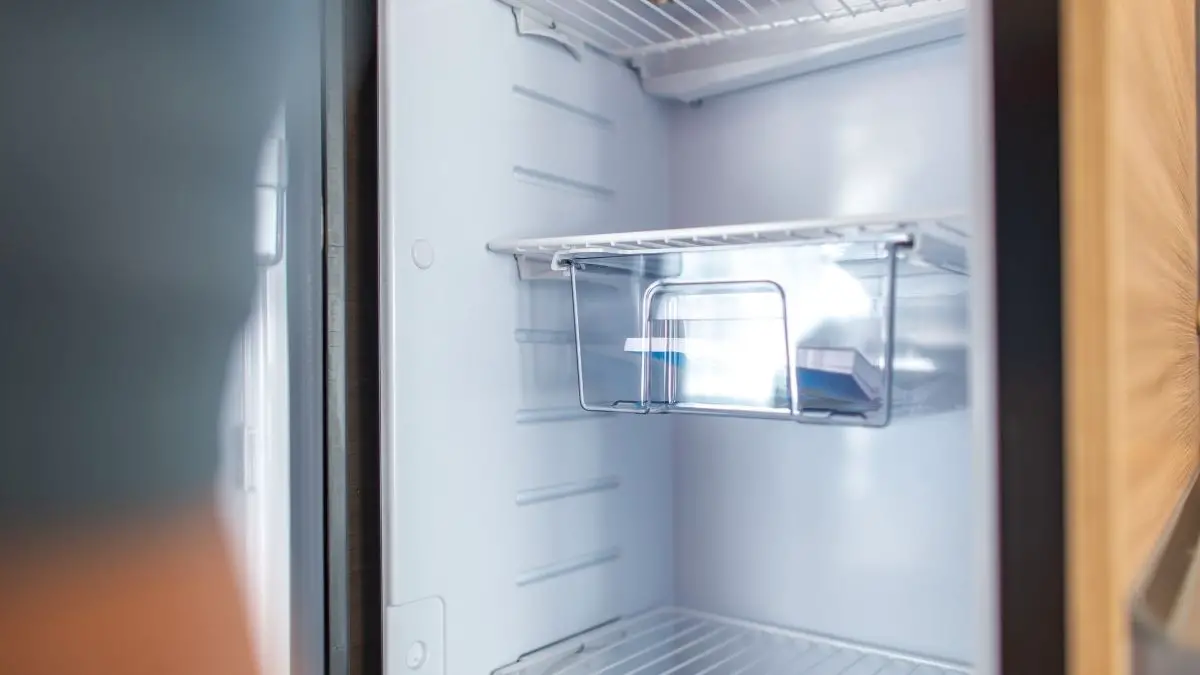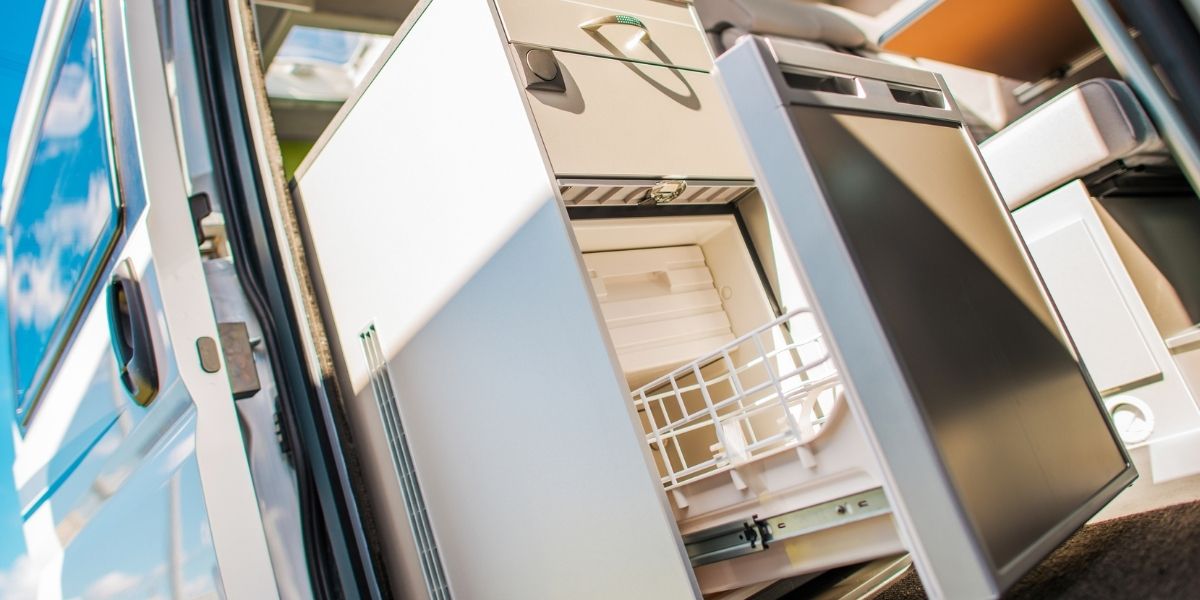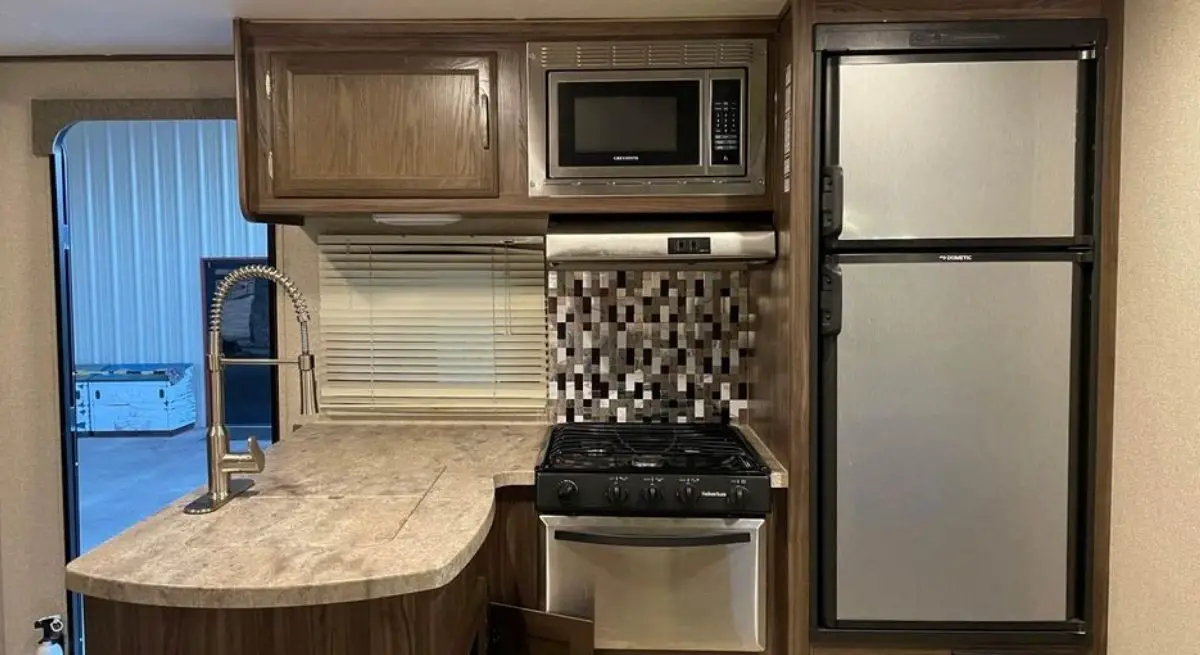Understanding how your RV fridge works, makes it easier to know what it needs to work properly, how to set it up on your RV and how to maintain it. With the different types and models, it could get confusing, especially if you’re trying to figure out a little troubleshooting or just want to make sure everything is running smoothly.
How Does Your RV Refrigerator Work?
Refrigerators work by transferring the heat from inside the unit to the outside. Compared to residential refrigerators, modern RV fridges have less movable parts and sturdier for travel, they don’t have a compressor and use a different cooling system, thus they’re known as “absorption refrigerators.” As I mentioned in a previous article on how an absorption refrigerator works, there are three phases: Evaporation, Absorption and the Reheating.
- Basically, the refrigerant (ammonia) inside the generator is heated, evaporates, and then moves into the condenser.
- The condenser is filled with hydrogen, and due to the low pressure, the ammonia expands quickly creating a cooling reaction inside the evaporator. The fan that blows on the evaporator is what circulates the cold air inside the refrigerator.
- For the ammonia to go back into the generator, the absorber trickles water through the evaporator, dissolving the ammonia (not the hydrogen) so it can go back to the start of the cycle.
There are three general types of RV fridges currently available on the market. These are refrigerator units that run on:
- Propane or electricity (also known as a “2-way fridge”)
- Propane, 12-volt DC or 120-volt AC power (also known as a “3-way fridge”). This means it can run on AC power (shore power/generator), propane gas and DC power (house batteries)
- 12-volt DC or batteries (available for RV refrigerators and thermoelectric coolers)
Most modern RV refrigerators have an auto-changeover, so it could switch between propane and electricity (shore power or battery) to which ever would be more economical. There’s also a manual switch to select the desired source to power the unit. Some RV technicians say that running your fridge on electricity is more economical, but it might not always be the most efficient. Do note, when I say efficient, in this context, your fridge should be able to chill the fridge interior properly at whichever setting/temperature you’ve put it at.
We’ve covered the general cooling mechanism of an average RV absorption refrigerator, so now we’ll cover how it works on the different power sources.
How Does a RV fridge Work on Electricity?
When it comes to the cooling mechanism when your fridge is on electricity, it will use a heating element to heat the refrigerant. You can read more about the difference of how the cooling system works when on propane in the next section.
Now, whether your RV fridge is on 120-volt AC (shore power/generator) or 12-volt DC (house batteries), it means it’s running on electricity. They may seem the same, but the 120-volt RV refrigerators are designed to operate between 108 to 132 volts, so if you even get to operate the unit at 108 volts, this means the efficiency of the refrigerator would still be lower than what’s ideal.
On the other hand, RV refrigerators that are designed to work on 12-volt DC are also essentially similar when it comes to the cooling system of a 120-volt RV refrigerators, except since they draw power from a battery which provides a constant one-way electricity flow, it can operate roughly on 10 amp hours in a day.
As a side topic, I will need to mention that it would always be best to check your refrigerator’s Operation Manual to really see how much power it really needs. You’ll also need to compute how much power you need to run everything, and I mean everything that runs on electricity, on your RV (light bulbs, coffee maker, laptop, phone charging, etc.), for everything to work properly. Why is this important? Because if you want to run, let’s say, just your 7000 BTU RV air conditioner (let’s say it requires 1700 watts to start it up, but will consume an average wattage of 600 watts once running) and your RV fridge (which for this example, would need 700 watts) for just one (1) hour — not including the initial startup — at 15-amp power at home or at a campground, the amps needed would be 5 amps for the air conditioner + 6 amps for the fridge per hour. If you want to try computing how much power you need, you can use the formula (Watts ÷ Voltage = AMPs) for every electrical item in your RV, and then add it all up.
How Does a RV Refrigerator Work on Propane?
On the other hand, if your RV refrigerator is on propane, the unit will simply use a flame to get the absorption system working. The flame starts when an igniter coil creates a spark once the regulating valve is opened (when you manually switch the fridge from electric to propane). Once you switch the fridge back from propane to electricity, this triggers the regulating valve to close, snuffing out the flame. Although it may seem daunting to have a small open flame operating your fridge when it’s on propane, it is relatively safe provided you’re doing all the manufacturer’s instruction, which you’ll see on your fridge’s User Manual, and all the other tips I’ve mentioned in the “How Do I Use My RV Refrigerator?” section below.
Does Your RV fridge Run Better on propane or Electricity?
The answer to this question will heavily depend on how your RV is setup, the RV fridge you have and which would be the most convenient/available option for you (if you’re boondocking, etc.). I can not stress it enough that you need to make sure that your RV has enough power to run the refrigerator (and all the other electrical items inside) &/or having enough propane (if this is the preferred choice to operate the unit) for it to work properly!
Regardless of your RV refrigerator type, age, or if it’s running either on AC/DC electricity, the performance of the refrigerator’s efficiency will heavily depend on the power source (assuming that there are no other issues — which I will be mentioning in another article: “RV Refrigerator Troubleshooting” (add URL)
I’ve noticed most people have less issues with their refrigerators when they’re on propane, since it is more consistent than electricity. So if you’re on it, and your refrigerator isn’t working as it used to, you could check the pilot light on your unit is working to see if there’s proper gas-flow (controlled by the thermocouple).
How Does a 12-volt RV Refrigerator Work?
As mentioned earlier, 12-volt RV refrigerators are simply running on DC power. I do need to mention that the type of battery you use is important in making sure it works efficiently (because you may have other things connected, especially if you use solar for that off-grid setup). Since batteries are measured in amp hours, a 12-volt RV fridge usually will consume ~10 amp hours per day (roughly 0.7 – 2.1 amps) on a 12-volt system.
When it comes to the 12-v refrigerator, the term “fridge” and “cooler” is often interchanged, but they’re technically very different. First is that they don’t need to be perfectly level. Compared to thermocoolers, the 12-volt refrigerators also are thermostat controlled. And lastly, most of the 12-volt RV fridge/freezers have a low voltage cut-off as a battery protection. This means that it won’t drain the battery.
How Do 12-volt Coolers Work?
The 12-volt coolers, also known as thermoelectric coolers, use a Peltier module. The air inside the unit is cooled by a thermoelectric plate which drops the temperature when an electric current passes from two different semiconductors (bismuth to the telluride). This means one side of the plate will get cooled down, while the other side will be heated by the Peltier effect. Thermocouples are connected in between the two plates, which are directly in contact with a fan to distribute the cool air, and a heatsink (since heat is generated).
Comparing this to a 12-volt refrigerator, the 12-volt coolers are not as efficient or effective, but they are simpler and more lightweight. They will consume more power though (expect between 20 amp hours to 60 amp hours depending on the model, or 3-5amps), since the Peltier effect requires a constant one-way electricity flow that only DC power can provide. Since they’re also not thermostat controlled, they can only hold an internal temperature of 4 degrees Celsius (40 degrees Fahrenheit) less than the ambient (surrounding) temperature you’re in.
As a side note, if you have an existing cooler and want to convert it to a 12-volt cooler, there are brands like Dometic, Norcold and Novacool that offer AC/DC conversion kits
Are There RV Refrigerators That Use Compressors?
Yes, of course there are. Companies like Dometic and Norcold are offering models with compressor technology for their RV refrigerators. They’re similar to residential refrigerators because of the presence of a compressor. But, some reviews have shown it most likely will consume more power than the usual absorption ones, and the concern about maintenance and replacement parts.
How Do I Use My RV Refrigerator?
Now that you have a general idea of how your fridge works, a good follow-up would be some tips that could help make sure your unit works properly. First and foremost, yes, your RV fridge needs to be reasonably level to work properly. And when I mean reasonably level, do check your RV level gauge and you’re not more than a 1/2 a bubble off. This is important because absorption refrigerators’s cooling system also uses gravity (in addition to the heat convection) for the chemicals to move around the phases. You can read more about it on the article I wrote just on this most asked question (HERE).
The cool air circulating inside the refrigerator is what will help cool the items inside. Even manufacturers suggest turning on the fridge a day before using the unit so it can take time to cool the interior. Most would also suggest not to overstuff the fridge, to give enough space for the cool air to move around (provided that the unit is operating properly with ample power).
Like any refrigerator, even the RV refrigerators will also produce heat and noise. So the ventilation on the outside of the unit and noise may need to be factored in, especially due to the limited space inside an RV. Ensuring there are no obstructions to the air flow, and there is adequate clearance around the refrigerator, is important. This is also because absorption refrigerators use a closed cooling system that’s properly sealed and welded together during assembly to prevent leaks. If the unit is working, but the boiler or absorber is hot, there’s probably a leak (smelling ammonia and finding yellow residue outside the cooling unit confirms this concern).
Conclusion
This may not be an exhaustive overview of how most RV refrigerators work, but I’m hoping it’s a good guide to help you understand the basics of whichever RV refrigerator you have.
As I’ve observed, having a good idea of how things work makes one appreciate it more, to help take care of it — so it lasts longer (since RV fridges can get pricey and is an investment) — plus it will give a good advantage in helping you decide which refrigerator to get, in case you don’t have one yet!




